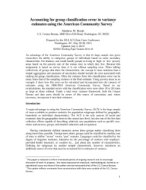
An official website of the United States government
Here’s how you know
Official websites use .gov
A .gov website belongs to an official government organization in the United States.
Secure .gov websites use HTTPS
A lock (
) or https:// means you’ve safely connected to the .gov website. Share sensitive information only on official, secure websites.
-
//
- Census.gov /
- Library /
- Census Working Papers /
- Accounting for Group Classification Error in Variance Estimates
Accounting for Group Classification Error in Variance Estimates Using the American Community Survey
Accounting for Group Classification Error in Variance Estimates Using the American Community Survey
Abstract
An advantage of the American Community Survey is that its large sample size gives researchers the ability to categorize groups of individuals based on some secondary characteristic. For instance, one could classify people as living in 'high' or 'low' poverty areas based on the poverty rate of the census tract in which they live. Because this assignment is based on survey data, it is not without sampling error. When talking collectively of groups that share the characteristic, the concept is more nebulous than a simple aggregation and measures of uncertainty should include the error associated with making the group classification. Often the variance from this classification error can be many times that of the sampling variance in the final estimate. Using poverty areas as an example, I show how this error can be calculated and incorporated into the variance of estimates using the 2006-2010 American Community Survey. Based on my recalculations, the standard errors with the classification error were often 10 to 50 times as large as those without. Under a total error variance framework, both the Census Bureau and data users should be aware of this source of uncertainty and, where necessary, incorporate it into their estimates.
Others in Series
Working Paper
Working Paper
Working Paper
Share
Related Information
Some content on this site is available in several different electronic formats. Some of the files may require a plug-in or additional software to view.
 Yes
Yes
 No
NoComments or suggestions?


Top

